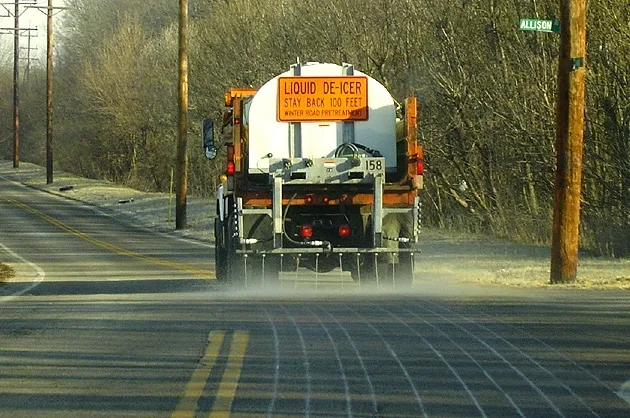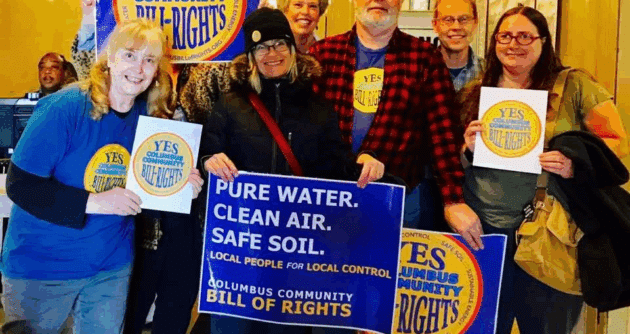FOR IMMEDIATE RELEASE
Tish O’Dell, CELDF Organizer, Ohio Community Rights Network
440-552-6774
celdf.org
tish@celdf.org
Bill Lyons, Ohio Community Rights Network
614-551-6194
ohiocrn.org
wmlyons@gmail.com
Under a 2002 law, introducing radioactive elements into Ohio drinking water is a felony offense.
Companies are violating this by spreading oil and gas waste ‘brine’ — proven by the Ohio Department of Natural Resources to contain radioactive concentrations that exceed federal and state standards — in critical watersheds. So are state actors, residents assert.
OHIO: On Friday, June 18 and Monday, June 21, Ohio residents handed letters to nine county prosecuting attorneys and the Ohio Attorney General’s Office demanding the enforcement of the Ohio Revised Code and launch of felony investigations into the disposal of radioactive waste in Ohio drinking watersheds. The residents charge that the crime of poisoning is knowingly caused by the spreading of radioactive oil and gas drilling “brine” on public highways as a deicer and dust suppressant. Poisoning is a first-degree felony in violation of O.R.C. § 2927.24.
Letters were delivered to the prosecuting attorneys in Athens, Cuyahoga, Franklin, Lucas, Medina, Portage, Mahoning, Williams and Wood counties as well as Attorney General Dave Yost.
Members of the Ohio Community Rights Network (OHCRN) delivered the letters along with packets of information on the toxicity of the brine. The packets support the need for criminal investigations into brine processing companies and the State of Ohio, for the spreading and legalization of radioactive brine throughout the state. OHCRN members have advanced local lawmaking to protect freshwater ecosystems across the State of Ohio, and in many cases the state has put obstacles in their way.
“State and private actors are violating Ohio’s criminal code by distributing and depositing radioactive oil and gas waste brine into Ohio watersheds,” said Terry Lodge, CELDF attorney. “State agencies are also guilty of permitting private actors to participate in this practice.”
According to tests run by the Ohio Department of Natural Resources (ODNR) in 2017, all tested samples of brine used for these purposes exceeded both federal and state standards of radioactivity limits into the environment. Despite these results, the radioactive substance is being spread in drinking water basins and ecosystems. Other tests run by independent researchers at Penn State, the National Resources Defense Council and Duquesne University have shown similar results.
According to a 2020 investigation published in Rolling Stone Magazine, the oil/gas industry is fully aware of these radiation issues and has been for decades.
The Ohio Legislature is currently considering bills (HB 282 and SB 171) that would further encourage the spreading of radioactive brine by reclassifying it as a commodity in the state. However, even without passage of these bills, the Ohio Department of Transportation and ODNR have both permitted and utilized this brine for several years throughout the state as a road deicer and dust suppressant.
“Section 2927.24 was added to the Ohio Code after the 9/11 attacks on this country. The fear was that ‘terrorists’ might attempt to attack the state’s water supplies with radioactive substances. It’s ironic that the government itself is the one violating its own law and putting all residents and ecosystems throughout the state in danger,” stated OHCRN President Bill Lyons.
The letters handed to the county prosecuting attorneys and Ohio Attorney General state:
“These concentrations of Ra-228 and Ra-226 are dangerous. Once oil and gas brine is applied to roadways, it will ultimately be washed into every surface water source in the state. The decay of Ra-226 to safe levels will take more than 11,000 years. Radium is very mobile in water and will come to pervade the water table everywhere throughout Ohio. It is misidentified by our bodies as calcium, and so would be deposited in bones and teeth, from whence it would bombard and mutate surrounding cells into cancers.”
“We have tried to bring this problem to the attention of our elected officials and have found that they are more concerned with protecting the profits of the oil/gas industry than protecting the people, the environment or the future of the state. We have been accused of breaking the law for attempting to pass laws banning this waste in our communities and now we find out that the state is breaking its own law. This needs to be exposed and dealt with,” stated Kathie Jones from Medina County.
Members of the Ohio Community Rights Network have pursued local laws in twelve counties to protect the rights of ecosystems and peoples’ rights to fresh water and to ban the spread and depositing of fracking waste in their communities. Some of those laws were adopted into law. Others collected sufficient signatures but have so far been denied access to the ballot. Petitioners whose ballot initiatives have not been allowed on the ballot are plaintiffs in an ongoing federal civil rights lawsuit against the state. The Community Environmental Legal Defense Fund (CELDF) has assisted the community groups with drafting legislation and legal representation.
“I’m infuriated that we would put a radioactive processing plant on the banks of this beautiful river and the people who are allowing this should be prosecuted and put in jail. We have criminals running the government,” stated Paul Sherlock, Cleveland resident and activist. “Here in Cleveland to have just witnessed so much celebration over the 50 year anniversary of the Cuyahoga River burning and ‘clean up,’ only to learn that the ODNR Chief has permitted a processing facility of this radioactive brine just a few feet from the banks of the Cuyahoga River. It may not burn this time, but the dangers are even worse.”
“What we have experienced over the past decade throughout Ohio is an assumption that the State would protect public health and the environment. When learning this wasn’t the case, people attempted to use the system to protect themselves by asserting their constitutional right to initiative,” says Tish O’Dell, CELDF Organizer and Ohio resident. “The government’s response to all the people’s efforts has been to erect new barriers to local self-governance and the protection of the rights of nature. Through court challenges, permitting harm and adopting preemption laws, all three branches of the state government have tried to stop residents from protecting their communities. The least the state can do is enforce its own laws it passed to protect our water supplies from ‘terrorists.’”
Former Youngstown Fire Chief Silverio Caggiano stated in the Rolling Stone article on radioactive brine: “If we caught some ISIS terrorist cells dumping this into our waterways, they would be tried for terrorism. . . . However, the frac industry is given a pass on all of this.”
***
To receive a copy of the information packet and test results from the Ohio Department of Natural Resources, Penn State, the National Resources Defence Council or Duquesne University, email tish@celdf.org.
To read testimony about HB 282/SB 171: https://www.legislature.ohio.gov/legislation/legislation-committee-documents?id=GA134-HB-282
###
About CELDF — Community Environmental Legal Defense Fund
The Community Environmental Legal Defense Fund (CELDF) is helping build a decolonial movement for Community Rights and the Rights of Nature to advance democratic, economic, social, and environmental rights – building upward from the grassroots to the state, federal, and international levels.
About OHCRN — Ohio Community Rights Network
The Ohio Community Rights Network was formed in 2013 with a mission to establish a network of just communities working to advance, secure and protect the inalienable rights of all Ohioans to democratic, local self governance, to sustainable food, energy and economic systems, and the rights of nature to exist and flourish throughout Ohio.
Photo Source: Protecting Our Waters


